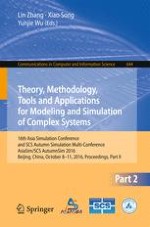2016 | Buch
Theory, Methodology, Tools and Applications for Modeling and Simulation of Complex Systems
16th Asia Simulation Conference and SCS Autumn Simulation Multi-Conference, AsiaSim/SCS AutumnSim 2016, Beijing, China, October 8-11, 2016, Proceedings, Part II
herausgegeben von: Lin Zhang, Xiao Song, Yunjie Wu
Verlag: Springer Singapore
Buchreihe : Communications in Computer and Information Science
